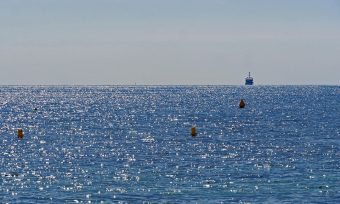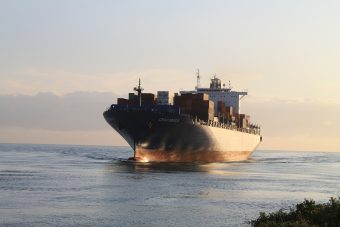
In the most recent Helsinki Commission (HELCOM) assessment (2011-2016), all the Baltic Sea basins failed to reach good environmental status as defined by the EU Maritime Strategy Framework Directive. HELCOM offers data on various heavy metals reaching the Baltic, from sources such as wastewater treatment plants and industry, plus modelled data of atmospheric deposition of metals such as cadmium and lead. However, it only considers emissions of a few substances from shipping (e.g. nitrogen dioxide) and concentrates on domestic shipping – metal pollution from maritime shipping and leisure boating are not explicitly included in HELCOM assessments.
To address this knowledge gap, researchers used available data to estimate the amounts of nine metals (arsenic, cadmium, chromium, copper, lead, mercury, nickel, vanadium and zinc) and 16 polycyclic aromatic hydrocarbons (PAHs) that enter the Baltic Sea from shipping and leisure boating each year. These estimates included discharges of bilge water, scrubber wash water, greywater and sewage, as well as antifouling paint. For leisure boats, only emissions of copper and zinc from antifouling paint were considered. Atmospheric deposition estimates were based on data from six land-based monitoring stations, which may not fully account for PAHs from ship exhaust.
Antifouling paint protects hulls from biota such as barnacles and seaweed. Its active ingredient is usually cuprous oxide, often combined with zinc oxide. Scrubbers wash exhaust gas systems, removing sulphur dioxides. The process produces large volumes of acidic water, containing metals and PAHs. Most scrubbers used in the Baltic are ‘closed loop’ or hybrid systems, which means that they can operate in closed loop mode and hence generate a lower volume of contaminated water than ‘open loop’ systems. Scrubbers operating in closed loop mode generate smaller volumes of wash water than open loop systems, but they can still be a substantial source of primarily metals and PAHs.
More:
- AIR POLLUTION LEVELS ACROSS EUROPE STILL NOT SAFE, ESPECIALLY FOR CHILDREN
- UN ENVIRONMENT PROGRAMME AND EUROPEAN INVESTMENT BANK JOIN FORCES TO REDUCE POLLUTION IN THE MARINE AND COASTAL ENVIRONMENT
- HOW CAN A LIFE-CYCLE APPROACH CURB THE PLASTIC POLLUTION CRISIS?
The researchers compared shipping emissions with inputs to the Baltic from other sources such as rivers, atmospheric deposition and coastal industry, based on the most recent data available, including the 2018 HELCOM assessment1 and the EBAS database2. From the sources included in this assessment, the most significant pollutant by mass was zinc, 3 932 tonnes (t) of which enters the Baltic Sea annually, followed by an estimated 1 560t of copper and 675t of nickel. After riverine input (at 54 percent), shipping and leisure boating were the second largest source of copper inputs (37 percent), the vast majority from antifouling paints – 509t from shipping and 57t from leisure boats. The researchers highlight that the latter amount is concentrated in the summer months, in sensitive coastal areas, so it is still significant. Scrubber discharge water contributes 7t of copper annually – about a third of the amount of copper that comes from all point sources (19t).

Contributing 3 132t, rivers made up the largest source (80 percent) of zinc inputs to the Baltic Sea. Shipping and leisure boats contributed 166t (3.6 percent) – again, mostly from antifouling paints. Shipping emitted also other metals in smaller amounts (e.g. 35t vanadium and 10t nickel). As a share of all sources, shipping was found to contribute nearly nine percent of the PAHs Phenanthrene and Anthracene (0.3t and 0.015t, respectively). It was also the source of about two percent (0.075t) of Pyrene and one percent (0.03t) of Fluoranthene. These four PAHs may form during combustion, and some are also used in products such as plastics, pesticides and dyes. All are toxic, and on the European Chemical Agency’s (ECHA) Candidate List of Substances of Very High Concern. Ships probably also contribute from their exhaust to PAHs deposited on the surface of the Baltic Sea, but there is no chemical transport model available to account for this, the researchers note. The study shows that shipping is a significant source of certain metals and PAHs in the Baltic Sea. It is particularly important to address copper emissions, since target levels have been exceeded in most areas of the Baltic [HELCOM 2021].
Baltic ships’ copper emissions could be reduced by a third, suggest the researchers, if alternative, copper-free paints or strategies were used. For instance, silicone-based anti-fouling paint is substantially less toxic for marine organisms, and could even be more effective in preventing fouling than copper-based coatings. However, it is worth noting that the monomers used to produce silicon polymers (D4, D5 and D6) are also on the ECHA’s Candidate List, so the paints would only be good substitutes if they contained very low concentrations of these monomers. On vessels that enter ice, inert coatings (that won’t be damaged by ice) together with hull cleaning are more suitable. As long as copper-based coatings are on the market, however, it is difficult to promote alternatives. The researchers also note that the release rate of copper in antifouling paints varies from 2–66 micrograms (μg) per square centimetre per day. Fouling pressure in the Baltic Sea is low, therefore lower release rates (<5 μg) are sufficient to prevent marine organisms from attaching and growing on the hull.
Another strategy to mitigate pollution would be to restrict scrubbers to closed-loop mode. Possible for most scrubber-fitted vessels in the Baltic, this could massively reduce their metal and PAH emissions. Growing use of scrubbers may have a perverse outcome, however. Since they reduce air pollution from exhaust, ship operators may continuously use high sulphur fuels – which are associated with higher emissions of metals and PAHs to water, compared to alternative fuels. To mitigate pollution, the best practice would be to avoid these fuels. Meanwhile, environmental impacts from the increasing use of scrubbers are uncertain, warn the researchers, and their chemical-laden discharge has been shown to be toxic to marine life. The researchers note that 178 of the 8 900 ships operating in the Baltic in 2018 had a scrubber (more than a ten-fold increase the last time data on their discharges was modelled, in 2012), but that figure may now be close to 500. Finally, since shipping and boating are the largest anthropogenic source of copper to the Baltic Sea, they should be included in HELCOM pollution load compilations, say the researchers.
Source: European Commission

